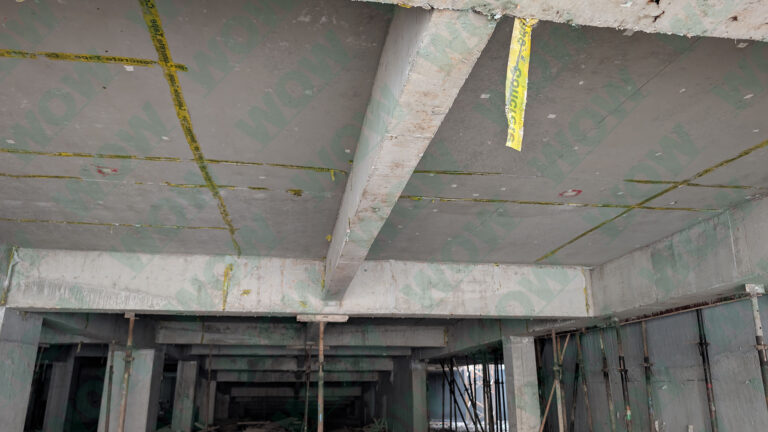Walk into any construction site — whether it’s a soaring high-rise in Mumbai or a small housing block in Kochi — and you will find a quiet but essential hero: centring plywood. These strong sheets of wood form the backbone of concrete structures, shaping everything from slender columns to wide slabs.
But what exactly makes centring ply so widely trusted in building shuttering work? And how does it help transform piles of steel rods and wet concrete into solid, precise structures? Let’s explore the role of centring plywood in formwork and why it remains a popular choice across India.
The heart of concrete: formwork
Before concrete gains its strength, it is fluid, almost like thick porridge. To shape it into beams, slabs, columns, or walls, builders rely on formwork — a temporary mould that holds the concrete until it hardens and supports itself.
This formwork is built using various formwork materials, including timber, steel, aluminium, plastic, and most commonly, centring ply.
What is centring plywood?
Centring plywood, often called centring ply or plywood centring sheet, is a special type of plywood designed for concrete shuttering applications. Unlike ordinary plywood used for furniture or interior decoration, centring plywood is engineered to withstand heavy loads, resist moisture, and maintain dimensional stability.
A typical centring ply board consists of multiple layers of wood veneers bonded together under high pressure. This cross-layered arrangement makes it strong and prevents warping.
Why centring plywood?
There are a few reasons why centring plywood is the go-to choice for many contractors:
1. High strength and load-bearing capacity
Columns and slabs exert considerable pressure on the formwork. A quality centring ply board is designed to handle these loads without bending or breaking.
2. Smooth surface finish
Good quality waterproof centring plywood ensures a smooth concrete surface, reducing the need for heavy plastering or surface treatments after de-shuttering.
3. Reusability
While not as durable as plastic or metal formwork, centring ply can still be reused multiple times when handled carefully.
4. Versatility
Centring plywood can be easily cut and shaped to fit complex architectural forms, making it highly versatile for all kinds of structures.
Columns: standing tall with centring plywood
When creating columns, builders use centring sheets to wrap around steel reinforcements, forming a hollow vertical mould. Once the concrete is poured and set, these sheets are removed, revealing the solid column beneath.
The smoothness of the plywood centring sheet helps achieve crisp edges and uniform finishes — essential in architectural designs where exposed columns are part of the aesthetic.
Slabs: wide, strong, and level
Slabs are horizontal concrete elements that form floors and roofs. Supporting these large surfaces requires an extensive network of props and centring ply boards to create a level, stable mould.
Here, the dimensional stability of waterproof plywood becomes crucial. Even slight warping can result in uneven slab thickness and finishing problems. Using high-quality waterproof centring plywood ensures precision and reduces the risk of deflection.
The price factor
One of the main reasons contractors continue to choose plywood over other materials is cost. The centring ply price in India remains competitive compared to alternatives like steel or aluminium.
However, while the upfront price is attractive, it is important to consider the lifespan. Plywood usually offers about 5–10 uses, depending on quality and maintenance. In contrast, plastic and metal formwork can be reused dozens or even hundreds of times, making them more cost-effective in the long run.
Rising interest in alternative formwork materials
While centring plywood still dominates, the construction industry is gradually exploring new options. Concrete shuttering materials now include plastic and composite panels, thanks to their higher durability and resistance to water.
Builders are also showing interest in recycled construction materials, such as recycled plastic formwork boards. These materials not only reduce dependence on wood but also support a circular economy by repurposing plastic waste.
Protecting plywood: the importance of waterproofing
Given India’s challenging weather conditions, waterproof centring plywood is highly recommended. When plywood absorbs water, it swells and loses strength, leading to deformation and a poor-quality finish.
To counter this, manufacturers apply special coatings or laminations that improve water resistance. Proper handling on site — such as storing boards off the ground and covering them during rain — also extends their usable life.
The role of centring plywood in modern construction
Despite the emergence of advanced materials, centring ply continues to play a crucial role in modern construction. Its balance of strength, workability, and affordability makes it an attractive option for a wide range of projects, from small homes to large commercial complexes.
It allows builders to move swiftly from columns to slabs, giving shape and strength to their visions.
Conclusion: evolving choices for a stronger future
Centring plywood has powered countless skylines across India, forming the hidden skeletons of our cities. While it remains a trusted choice, the industry is also awakening to more sustainable solutions like plastic and recycled plastic formwork.
By exploring concrete shuttering materials beyond traditional wood-based options — such as recycled plastic construction materials — we can build structures that are not only strong but also kinder to our forests and future generations.
Whether you continue with plywood or move toward newer, more durable solutions, understanding the role of centring ply helps make every building safer, more efficient, and more sustainable.
Ready to explore stronger, greener alternatives to centring plywood? Connect with our team to learn more about advanced formwork materials for your next project.

